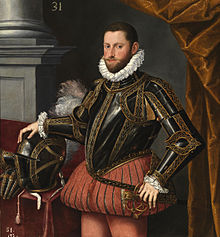Archduke Ernest of Austria
Appearance
This article relies largely or entirely on a single source. (October 2012) |
| Archduke Ernest | |
|---|---|
 Portrait by Alonso Sánchez Coello c. 1580 | |
| Born | 15 June 1553[1] Vienna |
| Died | 20 February 1595 (aged 41) Brussels |
| House | House of Habsburg |
| Father | Maximilian II, Holy Roman Emperor |
| Mother | Maria of Spain |

Archduke Ernest of Austria (German: Ernst von Österreich; 15 June 1553[1] – 20 February 1595) was an Austrian prince, the son of Maximilian II, Holy Roman Emperor and Maria of Spain.
Born in Vienna, he was educated with his brother Rudolf II, Holy Roman Emperor, in the court of Spain. In 1573 and 1587, he was a candidate for the throne of Poland. From 1576 onwards, he was governor in the Archduchy of Austria, where he promoted the counterreformation. In 1590, he became governor of Inner Austria as regent for his young cousin Ferdinand, and from 1594 to 1595 he served as governor of the Spanish Netherlands.
He died in Brussels in 1595.
Ancestry
References
- ^ a b Joseph Haydn, James Bertrand Payne: Haydn's universal index of biography from the creation to the present time: for the use of the statesman, the historian, and the journalist, E. Moxon, 1868. pp. 156
- ^ a b Press, Volker (1990), "Maximilian II.", Neue Deutsche Biographie (in German), vol. 16, Berlin: Duncker & Humblot, pp. 471–475; (full text online)
- ^ a b Wurzbach, Constantin von, ed. (1861). . Biographisches Lexikon des Kaiserthums Oesterreich [Biographical Encyclopedia of the Austrian Empire] (in German). Vol. 7. p. 19 – via Wikisource.
- ^ Wurzbach, Constantin von, ed. (1861). . Biographisches Lexikon des Kaiserthums Oesterreich [Biographical Encyclopedia of the Austrian Empire] (in German). Vol. 7. p. 112 – via Wikisource.
- ^ a b c Chisholm, Hugh, ed. (1911). . Encyclopædia Britannica. Vol. 15 (11th ed.). Cambridge University Press.
- ^ Cazacu, Matei (2017). Reinert, Stephen W. (ed.). Dracula. Brill. p. 204.
- ^ a b Charles V, Holy Roman Emperor at the Encyclopædia Britannica
- ^ a b c d Stephens, Henry Morse (1903). The story of Portugal. G.P. Putnam's Sons. pp. 125, 139, 279. Retrieved 11 July 2018.
- ^ Holland, Arthur William (1911). . In Chisholm, Hugh (ed.). Encyclopædia Britannica. Vol. 17 (11th ed.). Cambridge University Press.
- ^ Poupardin, René (1911). . In Chisholm, Hugh (ed.). Encyclopædia Britannica. Vol. 5 (11th ed.). Cambridge University Press.
{{cite encyclopedia}}: templatestyles stripmarker in|title=at position 77 (help) - ^ a b Vladislas II, King of Bohemia and Hungary at the Encyclopædia Britannica
- ^ Boureau, Alain (1995). The Lord's First Night: The Myth of the Droit de Cuissage. Translated by Cochrane, Lydia G. The University of Chicago Press. p. 96.
- ^ Noubel, P., ed. (1877). Revue de l'Agenais [Review of the Agenais]. Vol. 4. Société académique d'Agen. p. 497.
- ^ a b Harris, Carolyn (2017). Raising Royalty: 1000 Years of Royal Parenting. Dundurn Press. p. 78.
